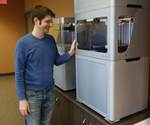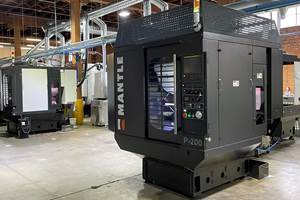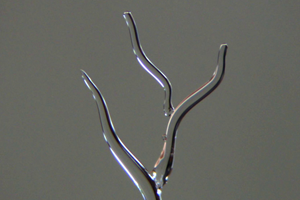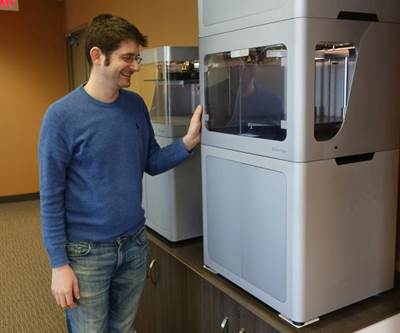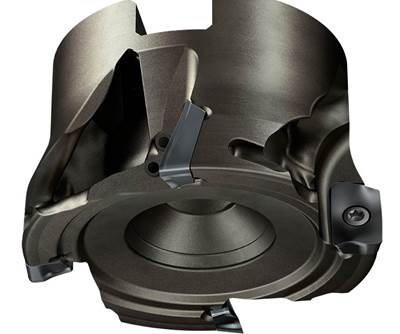3D Printed Tool for CNC Machining: The Cool Parts Show #17
Guhring uses additive manufacturing to make an end mill with optimized internal channels. We visit a machine shop to test the tool on this episode of The Cool Parts Show.
Is additive manufacturing (AM) a complement to the computer numerical control (CNC) machining used for “subtractive” manufacturing, or it a competitor? Answer: It is both, as a cutting tool from Guhring demonstrates. The tool is an end mill for precise metal cutting. Tools such as this that are used for machining are typically also made through machining. However, metal 3D printing was used to make this end mill because the choice makes machining better. With 3D printing, contoured internal channels could be built into the solid tool for more effective delivery of coolant.
In this episode of The Cool Parts Show, we explore the overlap between additive manufacturing and machining. We also leave the studio to go visit a machine shop where we test this 3D printed tool. | Season 3 of The Cool Parts Show brought to you by Carpenter Additive.
The Cool Parts Show is a video series from Additive Manufacturing Media that explores the what, how and why of unusual 3D printed parts. Watch more here.
Have a cool part to share? Email us.
Related resources
- Cutting tool maker Guhring
- 3D printed tools are becoming a thing. Examples from the biggest machining trade show.
- Another example: milling tool made from titanium
- More about the Markforged Metal X system used to make the Guhring tool
- Metal 3D printing in a machine shop
- Profile of Dan’s Custom Machining
- Video: conversation with Dan
- Thank you, Edge Factor, for machining footage
Transcript
Peter Zelinski, Additive Manufacturing
Additive manufacturing, subtractive manufacturing: Do they go together? Do they compete? We're going to talk about machining on this episode of The Cool Parts Show.
Stephanie Hendrixson, Additive Manufacturing
Season 3 of The Cool Parts Show is brought to you by Carpenter Additive. The company's Athens Alabama Emerging Technology Center is an end-to-end additive manufacturing production facility with everything from materials development through post processing under one roof, ready to help you with your next metal 3D printing job. Check them out at CarpenterAdditive.com Now back to the show.
Peter Zelinski
I'm Pete Zelinski.
Stephanie Hendrixson
I'm Stephanie Hendrixson.
Peter Zelinski
We are with AdditiveManufacturing.media.
Stephanie Hendrixson
And this is The Cool Parts Show, our show all about cool, unique and weird 3D printed parts.
Peter Zelinski
This is season 3 of The Cool Parts Show. We're starting a brand new season. Stephanie, it feels like it took a long time to get here.
Stephanie Hendrixson
You know, it kind of did, like it's been a while since we had a regular season. But we've been doing a lot of episodes in the meantime focused on things related to the coronavirus pandemic, checking in with past subjects of the show. But now we're kind of back to a point where it sort of feels like business as usual.
Peter Zelinski
Yeah, back to cool parts.
Stephanie Hendrixson
Okay, Pete. So I just said that this is our show about 3D printed parts. But it looks to me like you've brought us something from the subtractive manufacturing world and your other job, because that looks to me like some kind of cutting tool for machining. And so for our audience who might not know, in addition to hosting The Cool Parts Show and being editor in chief of Additive Manufacturing, my co host Pete is also the editor in chief of Modern Machine Shop, which is a sister publication that's focused on metalworking and CNC machining.
Peter Zelinski
Modern Machine Shop, all about machining. It's actually how I first met Stephanie who began as an intern on Modern Machine Shop. So yeah, we are going to talk about machining today.
Stephanie Hendrixson
Okay, so before we get too far into this episode, maybe just give us a quick rundown, what is machining?
Peter Zelinski
Yeah. Machining, in a way sort of the opposite of 3D printing. In 3D printing you build a part starting from nothing, build up the form in layers. In machining, you start with a larger form and you make the part by precisely cutting down to the shape you want. It has traditionally offered the most efficient way to get a small batch of parts a small quantity of precise parts. 3D printing now sometimes offers a faster way to get a small quantity of parts.
Stephanie Hendrixson
Okay, so you're describing two fundamentally different ways at arriving at a part or arriving at small quantities of parts, building material up or taking material away. Do you think that 3D printing and machining are competing with each other? Are they complementary? What is their relationship?
Peter Zelinski
So the answer is yes, yes to both of those questions, and that's what this part shows. That's what we're going to talk about today. This is a tool for cutting in machining, this is an end mill. So this cutter would be spun rapidly inside of a machining center and used to take lots of precise cuts really fast from a metal workpiece. It was made through 3D printing not the conventional way to like this is made but the way this one was made. Specifically, the tool body was made through 3D printing, it's made of H13 tool steel. The cutting edges are something different, they're polycrystalline diamond, PCD, they were added later. But the value of 3D printing this tool, part of it at least is these cooling channels. There are channels for cutting fluid that run through this tool. And the freedom to control the inner geometry through additive manufacturing allows these channels to be shaped and positioned exactly where the cutting tool maker wants them to be. So this is a more effective end mill. This is a better performing endmill for milling aluminum, the purpose it was designed for. So in that sense here is 3D printing complementing machining, but in another sense here is 3D printing competing with machining because machining is the way this tool would have been made in the past. Now it was made additively instead.
Stephanie Hendrixson
Okay, so there's a lot to dig into there. But one thing you said that was interesting is that this is an end mill but it's not just any end mill it has these cooling channels through it. Can you talk about why you would want to put holes through your cutting tool?
Peter Zelinski
Sure, sure. So in machining frequently commonly there is cutting fluid involved, cutting fluid delivered at a high pressure and it serves multiple purposes. It's called coolant and it does cool the cutting edge prevent the cutting edge from heating up for a better performing cut in most cases, but in addition, the coolant the cutting fluid also gets chips out of the way. The metal chips that are removed through milling could get in the way of milling if they stick to the tool or if they remain in the cut. So the coolant delivered at high pressure can flush them away. Now, oftentimes that coolant that cutting fluid is delivered through a nozzle that is external to the process that is pointed at the tool. But if this tool is buried in the metal, maybe that fluid isn't reaching it effectively. So an alternative is the spindle that is rotating this rapidly inside the machine. Maybe that spindle is designed so that there is a cutting fluid channel running straight through it. And then continuing straight through this tool that has its own port through the body of the tool to deliver that cutting fluid, not from outside but through the tool and so it shoots out right near the cutting edge. Cools it blows those metal chips out of the way. The problem though, is traditionally how do you make that through the tool coolant channel? Well you drill. You drill a straight line this way, you drill a straight line from the side you hope that they meet. There's very little control over the cutting fluid channel that you can get. 3D printing of course you can have any shape you want any position you want. Get those fluid channels exactly where you want them to be delivering the fluid exactly the way you want.
Stephanie Hendrixson
Okay, so enough machining talk for now let's get to the 3D printing. Who made this tool?
Peter Zelinski
Guhring, cutting tool maker headquartered in Germany, but they have locations around the world. It's actually Guhring in the UK that made this tool.
Stephanie Hendrixson
And what was the printing process?
Peter Zelinski
Sort of a variation on FDM or fused filament fabrication, FFF. This was made on a Markforged Metal X machine, which is a metal 3D printer that uses polymer filament, carrying the metal powder as a way to build up the form of the part. The process produces an oversized version of the part and then in a sintering process, the polymer material is melted away. And the form shrinks down to the precise solid metal form that the process produces.
Stephanie Hendrixson
Okay, but you said earlier that this tool has PCD cutting inserts. So there's more to the process than just the 3D printing, right?
Peter Zelinski
So that's right. So, yeah, to talk about the total process I'll let Guhring take it. So here is Alan Pearce, who is the PCD supervisor.
Alan Pearce, Guhring
Once the tool has been printed on the Metal X, this is known as a green part. The next step is to remove the primary binding or wax from the material. This is done using a washing and drying process. Once the part is dried this is then known as a brown part. At this stage it's very delicate. Next we place the part into the sinter. At present the part is 20% bigger. This process turns the party into a dense metal and correct size due to the shrinkage, ready for the final operations. Once we have a tool body, we can now brace segments into the pockets, grind our shank to h6 tolerance, and finally wire the PCD segments to our required cutting diameter.
Peter Zelinski
So Alan described how the parts shrinks during sintering. And I've got the pre-sintered green form right here, you can see how much bigger it is.
Stephanie Hendrixson
That's pretty cool. That's a pretty big difference.
Peter Zelinski
It is and it shows how controllable and predictable the shrinkage is. So predictable that they know they're going to end up with this precise solid metal part.
Stephanie Hendrixson
Okay, so we've talked about what this tool does. We've talked about how it was made, but I guess my big question now is why? You know Guhring is a tooling company, they have other ways of making tools. Why 3D printing?
Peter Zelinski
So Guhring has successfully made cutting tools like this for a long time without 3D printing. Why 3D printing? A lot of reasons. One is lead time. So with 3D printing, there are fewer steps. The the form of the tool body is essentially done, very close to done after the 3D printing process. So a way to deliver tools to the customer more quickly. A way to do small quantities. Right? So this tool, a diamond cutting edge is cutting aluminum, it's gonna last a long time, and the user might not order all that many. So 3D printing offers a cost effective way to do small batches, particularly if they're small batches of an unusual tool design they might not get another order from. In addition, there's the cooling channels that we described. The ability to control internal geometry to such an extent that these channels that deliver the cutting fluid are just so, just the right shape, just the right location with respect to the cutting edges. But, you know, we talked initially about how additive is different and the ability to start with nothing and you know, build the form from the inside out. There's more going on here than just the cooling channels. As a result of being able to build the part this way, this tool is actually lighter than it would be if it was made conventionally, thanks to 3D printing. Here's Alan Pierce again, who will talk a little bit more about why that is.
Alan Pearce
When comparing tooling made by both 3D printing against conventional tooling we found they performed the same when we ran them back to back on trials. The main advantage of the 3D printed tool was the weight. Our printed tool in a holder was 30% lighter in weight, due to the triangular infill structure achieved by printing. The lighter weight of the tool is a big advantage when on a tool change machine. When it's printed, we can change the actual outside layer. You can have anything from half a mil up to two mil. So we give the the outside layer the maximum so two mil, but then the infill is triangular, honeycomb, triangular honeycomb, and that's where you get the lightness.
Stephanie Hendrixson
Okay, so I gotta hand it to you this turned out to be a pretty cool part even if it came out of the machining world. And I think I almost have this but just one more question. Will it mill?
Peter Zelinski
That is a good question. Um, know what, I know a guy.
Peter Zelinski
We are at Dan's Custom Machining, machining job shop in Williamsburg, Ohio. Dan. Stephanie.
Stephanie Hendrixson
Nice to meet you.
Dan Donaworth, Dan’s Custom Machining
Nice to meet you.
Peter Zelinski
So you've been milling with that tool?
Dan Donaworth
Yep.
Peter Zelinski
How did it do?
Dan Donaworth
Doing great.
Peter Zelinski
So can we see some machining now?
Dan Donaworth
Yeah, let's go.
Peter Zelinski
So Dan, we're milling on a vertical machining center. What machine is this?
Dan Donaworth
It's a Hurco VMX42i.
Peter Zelinski
What are the parameters you're cutting at?
Dan Donaworth
We're cutting this tool at 1640 surface feet per minute, which comes out to 10,610 rpm and we're feeding at 6 thousandths per tooth feet rate, which is equal to 188 inches per minute.
Peter Zelinski
This is aluminum right?
Dan Donaworth
This is aluminum 6061 and we are at 590 thousandths depth of cut with a 59 thousandths width of cut.
Peter Zelinski
Thank you. So would you have known this was 3D printed?
Dan Donaworth
Nope, I would have never been able to tell.
Stephanie Hendrixson
How does cutting with this tool compare to cutting with a regular through coolant tool?
Dan Donaworth
The performance and speed we were able to achieve is almost identical, if not the same as a solid carbide tool would be.
Peter Zelinski
Thank you Dan.
Dan Donaworth
No problem. Thank you.
Stephanie Hendrixson
Okay, so confirmed 3D printing cutting tool will cut aluminum. So I think I'm ready to recap this.
Peter Zelinski
Okay.
Stephanie Hendrixson
This is a 3D printed end mill with PCD inserts. 3D printed by Guhring in the UK using the Metal X process from Markforged. This particular cutting tool has coolant channels through it to help with with cooling and chip removal in the cut. And it also has an infill that makes it 30% lighter than a comparable tool. And yes, it mills.
Peter Zelinski
Alright, I think that does it. That is a wrap. Thank you for watching The Cool Parts Show. Thank you for joining us at the start of season three. 3D printed cutting tools, that's a thing. If you want to read more about more examples of tools like this see a link in our show notes. See the show notes for more about the interplay between additive manufacturing and machining, and stick around season three is just getting started. We've got a lot more cool parts we want to talk to you about.
Stephanie Hendrixson
If you're 3D printing a cool part that you might like to see featured, email us cool parts at AdditiveManufacturing.media.
Peter Zelinski
If you're new to the show, you want to watch season one, season two, our special episodes, TheCoolPartsShow.com watch our stuff.
Stephanie Hendrixson
You can find them on YouTube as well. And while you're there, make sure to subscribe so you won't miss any new episodes. Thanks for watching.
Stephanie Hendrixson
Thank you to our sponsor Carpenter Additive. Listen to additive manufacturing podcasts, attend webinars and learn more at CarpenterAdditive.com
Related Content
Mantle: 3D Printed Molds Address Plastics Industry Lead Time and Skills Shortage
Company now shipping production systems. Steel mold tooling from its TrueShape process can be printed, shaped and sintered in days, and with fewer steps, compared to weeks of lead time for molds made conventionally.
Read MoreCopper, New Metal Printing Processes, Upgrades Based on Software and More from Formnext 2023: AM Radio #46
Formnext 2023 showed that additive manufacturing may be maturing, but it is certainly not stagnant. In this episode, we dive into observations around technology enhancements, new processes and materials, robots, sustainability and more trends from the show.
Read MoreQ&A With Align EVP: Why the Invisalign Manufacturer Acquired Cubicure, and the Future of Personalized Orthodontics
Align Technology produces nearly 1 million unique aligner parts per day. Its acquisition of technology supplier Cubicure in January supports demand for 3D printed tooling and direct printed orthodontic devices at mass scale.
Read MoreIce 3D Printing of Sacrificial Structures as Small as Blood Vessels
Using water for sacrificial tooling, Carnegie Mellon researchers have created a microscale method for 3D printing intricate structures small enough to create vasculature in artificial tissue. The biomedical research potentially has implications for other microscale and microfluidics applications.
Read MoreRead Next
FFF 3D Printing for Metal: Sintering Can Wait
Separating 3D printing from high-temperature processing is part of how the Markforged Metal X realizes a price less than established metal AM equipment.
Read MoreAM Is Advancing into Tools for Machining: Examples from EMO
The design freedom of additive manufacturing delivers increased performance to tools used in subtractive processes. At the world’s leading exposition for machine tools, I saw various examples of this.
Read MoreLightweight Sandvik Cutting Tool Employing Topology Optimization Now Available
Additive manufacturing aids “subtractive” CNC machining. We first saw this tool in an early version last year. See the video in this post.
Read More

